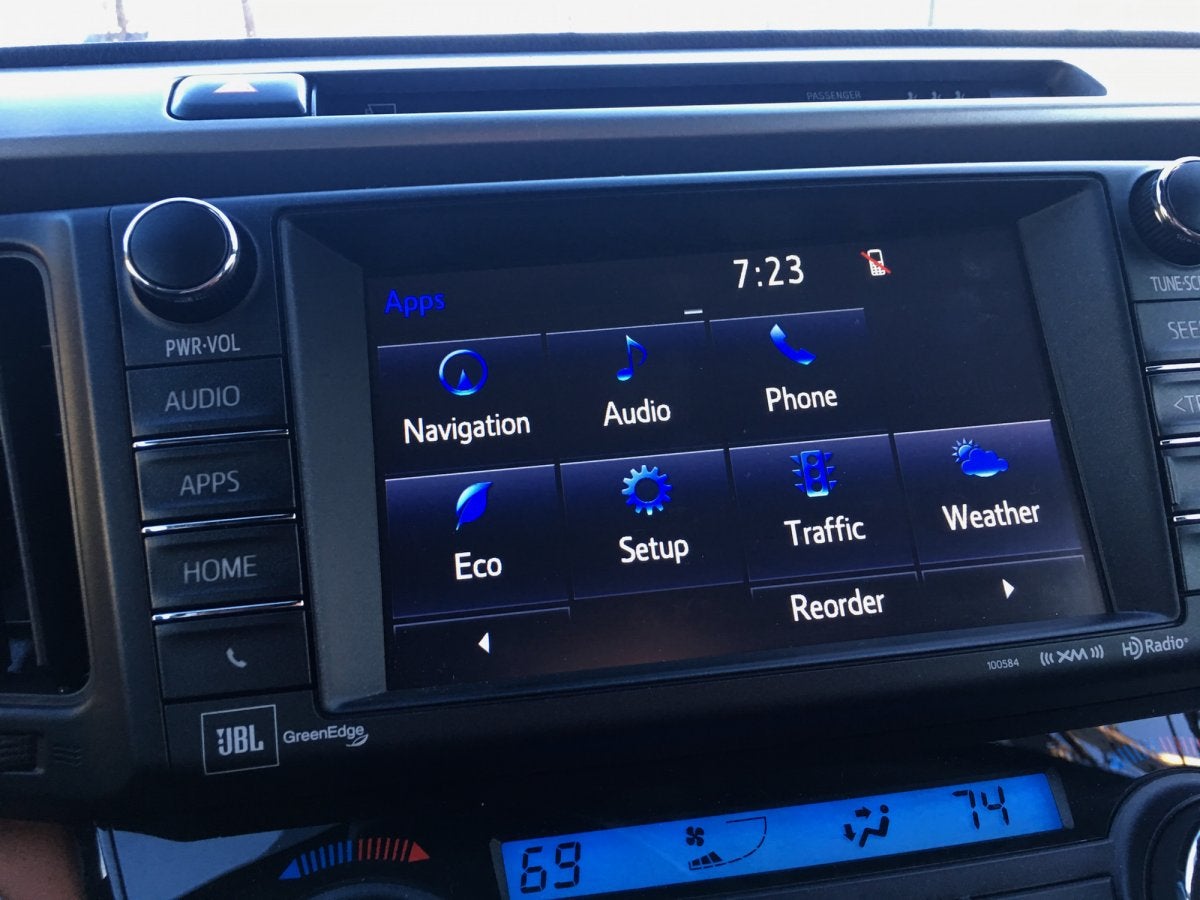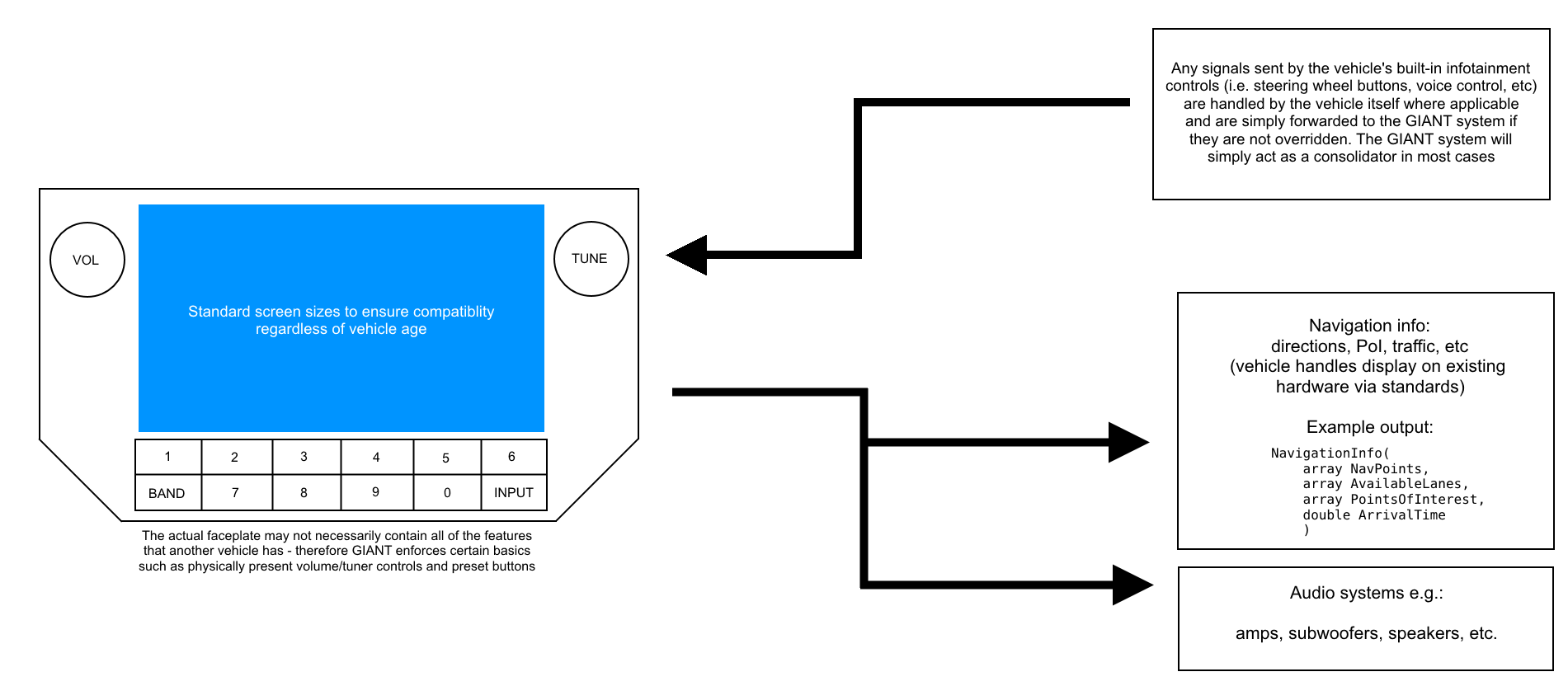 "winterlegacy, here 'till the end" (winterlegacy)
"winterlegacy, here 'till the end" (winterlegacy)
10/24/2018 at 20:05 • Filed to: thoughts with winterlegacy
 1
1
 11
11
 "winterlegacy, here 'till the end" (winterlegacy)
"winterlegacy, here 'till the end" (winterlegacy)
10/24/2018 at 20:05 • Filed to: thoughts with winterlegacy |  1 1
|  11 11 |

A RAV-4's infotainment system. This is a good way to go about doing an infotainment system, but isn’t perfect.
Modern automotive infotainment systems are awful. Sure, the software might be great, and it might be the best thing ever designed - but as we all know, what we consider great now will become obsolete within 5 to 10 years. We’ve seen that far too many times to count. It’s why aftermarket radio units were made that support extra outputs and are generally better in terms of functionality than the units they were designed to replace.
So why not apply that to the infotain ment systems in automobiles?
Enter my grand idea - the General Infotainment And Navigation Terminal, or GIANT . (Sorry, I couldn’t resist making a backronym.)
The first thing GIANT would do is to set standards for connectors/ports and how they link up into the vehicle’s system. Each connector would be designed around a specific purpose (ideally with as much future-proofing as possible,) and allow for expansion with such thing as aftermarket amps and woofers. The major thing to do would be to integrate it such that the main unit can send and receive information related to telephone calls, navigation data, etc. that smoothly integrates with the vehicle’s existing system. For example, a hypothetical vehicle integrates a “next turn” system into its gauge cluster display. This display should be capable of accepting information from any number of infotainment systems, including factory systems, using a standard protocol that contains all of the necessary information - and ideally the protocol will be forwards- and backwards-compatible for eternity, meaning that the system will only read the information it needs and discard anything else. The other thing would be to make buttons compatible with a generic standard that allows the OOBE (out of box experience) to be as smooth as possible with as many systems as possible, but allowing advanced users to rebind and/or outright disable certain buttons should the system send a signal that the GIANT system doesn’t entirely understand (either because the vehicle itself is too old or too new for the system itself to know what’s going on. )
A standard array of connectors might include the following:
Vehicle-to-system data bus (think of
something like a motherboard’s 24
-pin connector) - handles reading
vehicle speed for the all important “we’re not liable if you crash”/speed-controlled volume, dimmer switch, navigation data, etc.
Power connector
Standard audio connector - can feature extra connectors for vehicles that support this, think of it like a modular power supply that lets you plug in and remove cables you’re not using.
GIANT would heavily discourage the integration of functions such as HVAC controls into the system without physical backups in the event a GIANT system fails. Any system exclusively controlled through the touch screen should be non-critical, such as music, navigation or seat massaging , and should automatically default (in the event of a failure state) to being off.
The next
thing GIANT would do would be to set a standard for infotainment system form factors. These form factors would be based around current infotainment system form factors that are the most reasonable, such as the Mazda tack-on infotainment system format, and the Toyota image used above. It isn’t entirely necessary to stick with a GIANT form factor, allowing Volvo-like
integrated
systems to exist, however a standard form factor would allow third parties to make their own GIANT-compatible systems for aftermarket installation. A manufacturer like Kenwood or Pioneer could make their own GIANT unit that is a drop-in replacement for, say, the 180mm
“
widescreen”
form
factor, or one for the 130mm “square” form factor. All that a GIANT unit would handle is being the display/touch interface/GPS controller/etc for the vehicle - it would not require replacing a faceplate or fabricobbling a new one. Space would be made for water-tight gaskets and
systems for something i
n the future where we can just power wash an interior because it’s all made of rubber or something like that.
Here’s a really crappy mockup that I made that hopefully explains a little bit of it.

You’ll definitely want to zoom in on this one.
I’ve run out of ideas for now - but I’ve been thinking about how a system like this could work if time was spent to create a universal system that was cheap and easy to implement for an automaker, one so cheap that spending the amount of time they do to make an in-house system would be pointless when they could just contract out to a maker of GIANT systems to have their own corporate skins and add-ons attached to a GIANT device, much like how an Android device can have a corporate theme applied to it.
I think way too much about these things.
 Distraxi's idea of perfection is a Jagroen
> winterlegacy, here 'till the end
Distraxi's idea of perfection is a Jagroen
> winterlegacy, here 'till the end
10/24/2018 at 20:25 |
|
One of the thi ngs I really appreciate about Toyota’s “of course you’re going to modify it, so lets make that easy” approach to the GT86 is that the shitty factory infotainment system is (or was, in my case ) a n old-school single-DIN format stereo that didn’t control anything but the sounds . There can’t be too many new cars left which co me with DIN stereos and separate buttons for all the non-audio stuff , more’s the pity.
 If only EssExTee could be so grossly incandescent
> winterlegacy, here 'till the end
If only EssExTee could be so grossly incandescent
> winterlegacy, here 'till the end
10/24/2018 at 20:25 |
|
Or, now this may sound crazy, automakers could make their own proprietary systems that are difficult or impossible to upgrade so that you have to pay even more money for whatever premium sound system the automakers provide.
 winterlegacy, here 'till the end
> Distraxi's idea of perfection is a Jagroen
winterlegacy, here 'till the end
> Distraxi's idea of perfection is a Jagroen
10/24/2018 at 20:32 |
|
That’s the thing - every manufacturer is going all in on the touchscreen/infotainment crap. It’s going to end up like the old 90s radio systems with built in equalizers, except they won’t be as much of a novelty because they probably won’t work well anymore.
 nermal
> winterlegacy, here 'till the end
nermal
> winterlegacy, here 'till the end
10/24/2018 at 20:33 |
|
The only problem with this is that, as a general rule, automakers don’t give a shit about “future proofing” their vehicles.
Their goal is to sell new cars. Most people buying new cars don’t give a shit about what will happen in 10 years, because they will have bought 2 other new cars in that time period. New car buyers want cool new shit that their old car doesn’t have.
Automakers DON’T want standards like what you are proposing, because that limits the way they design the Cool New Shit in their interiors to attract new buyers.
 winterlegacy, here 'till the end
> If only EssExTee could be so grossly incandescent
winterlegacy, here 'till the end
> If only EssExTee could be so grossly incandescent
10/24/2018 at 20:33 |
|
It’s not like they don’t do that already...
They never change, do they?
 winterlegacy, here 'till the end
> nermal
winterlegacy, here 'till the end
> nermal
10/24/2018 at 20:34 |
|
And that’s the kicker. It’s easier to crap out something that has a shelf life so you’re guaranteed to have them crawling back to the dealership 5 years later, or just get them in on a lease after they give up.
 Aremmes
> winterlegacy, here 'till the end
Aremmes
> winterlegacy, here 'till the end
10/24/2018 at 20:36 |
|
An example could be learned from the marine electronics industry. A boat can have sensors, displays, and nav/pilot computers
from different
brands with a reasonable level of compatibility. T
here’s
only a small number of protocols - NMEA 0183 over RS-422, NMEA 2000 over CAN-BUS/DeviceNet, and SeaTalk - and options exist for bridging between protocols. Automobiles have gotten to the current state of affairs because manufacturers have relegated audio
/nav/infotainment systems to afterthought status for too long and are now scrambling to integrate them with the rest of the vehicle-driver interface, yet still do not have a view of the system as a whole
 nermal
> winterlegacy, here 'till the end
nermal
> winterlegacy, here 'till the end
10/24/2018 at 20:40 |
|
It has to be good enough that it doesn’t kill residual values on leases.
The more expensive the vehicle, the less an issue it is.
 aquila121
> Distraxi's idea of perfection is a Jagroen
aquila121
> Distraxi's idea of perfection is a Jagroen
10/24/2018 at 21:08 |
|
I think early 2000's Subarus had the same logic--some statistic like 75% of WRX owners toss the stock stereo for an aftermarket unit, so Subaru forgoes on an upgraded audio package shortly after.
 jimz
> winterlegacy, here 'till the end
jimz
> winterlegacy, here 'till the end
11/01/2018 at 12:50 |
|
the bottom line is that the manufacturers have practically no incentive to support something like this, because it nets them no return.
 jimz
> Aremmes
jimz
> Aremmes
11/01/2018 at 12:54 |
|
Automobiles have gotten to the current state of affairs because manufacturers have relegated audio/nav/infotainment systems to afterthought status for too long and are now scrambling to integrate t hem with the rest of the vehicle-driver interface, yet still do not have a view of the system as a whole
This is false. the radios I work with day to day are not only AM/FM/sat receivers (with or without CD) they are also the chime generator (for warning/info chimes,) the ANC/ESE processor, and the primary mixer/processor for every media source in the vehicle. They are quite tightly integrated into the system.